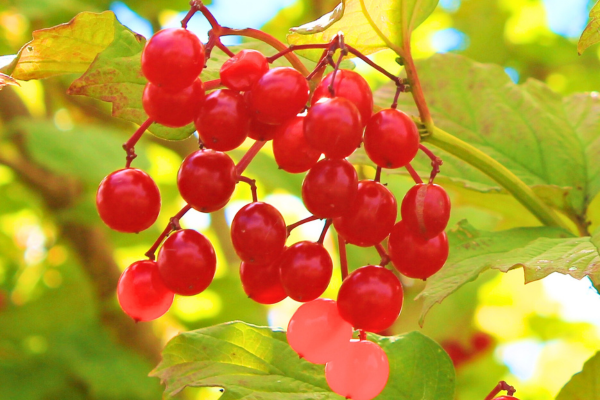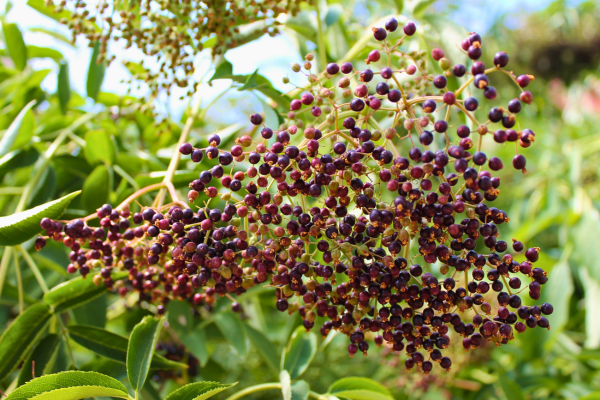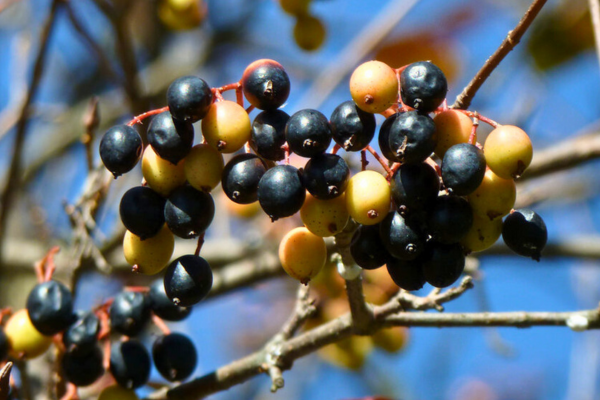Of the many native edible shrubs we have in Southern Ontario, LEAF offers ten species, with a range of different types of tasty fruit. All this variety leaves room for so much diversity in your garden and creativity in your kitchen! Here are three edible native shrubs and some ways you can cook with them!
Highbush Cranberry Cake
Highbush cranberry (Viburnum trilobum) produces clusters of small, round, red fruit which mature in late summer to early fall. While songbirds love them as a late season treat, the raw berries taste quite bitter to humans and are best used to make jams, jellies, juices and syrups.

This is a delicious recipe for highbush cranberry cake that my friend’s mother shared with me. I remember spending late summer days at their house eating this cake, made with freshly picked berries from their yard. Note: you can also make this cake with other native fruits such as black chokeberry, lowbush blueberry, northern wild raisin and serviceberry.
Ingredients:
- 450 g flour
- 250 g softened butter
- 4 egg yolks & 4 egg whites - separate the egg yolks from the egg whites
- 1 whole egg
- 2 tsp baking powder
- 4 cups highbush cranberries
- 150 g icing sugar
Steps:
- Mix the flour, softened butter, egg yolks, whole egg and baking powder together in a large bowl. Finish combining the dough with your hands.
- Separate the dough in half and put one half in the freezer.
- In the meantime, evenly spread the other half of dough in a large baking pan, making sure the dough is spread thinly along the bottom of the pan.
- Add the highbush cranberries on top of the dough and sprinkle icing sugar all over. If you have a sweet tooth, you can add more sugar to offset the sour berries.
- Beat the egg whites in a bowl until it is a foamy consistency, then pour on top.
- Take the other half of the dough out of the freezer and grate the cold dough on top.
- Bake at 350°F for about 45 mins or until golden brown.
- Let the cake cool, sprinkle on some more icing sugar and enjoy!
Common Elderberry Tea
Common elderberry (Sambucus canadensis) produces clusters of tiny, round, dark purple to black drupes (fleshy fruit) containing three to five small seeds per drupe. Like highbush cranberry, they also mature in the late summer to early fall, making it a tasty treat for over 45 species of birds. The fruit is rich in antioxidants and even contains a higher concentration of vitamin C than oranges! Elderberries are best eaten when cooked and can be used to make pies, jellies, juices, wines and tea!

Since elderberries have so many healthy properties, elderberry tea is a popular way to ease cold and flu symptoms. Some studies also suggest that elderberries can boost your immune system! Here is a quick and easy recipe for an antioxidant-packed elderberry tea.
Ingredients:
- 2 cups of water
- 2-3 tbsp of dried, fresh or frozen elderberries
- Honey to taste (optional)
- Freshly squeezed lemon juice to taste (optional)
Steps:
- In a small saucepan, combine the elderberries and water and cook over high heat. When the tea starts to boil, turn the heat down to low and simmer for 15 minutes.
- Once the tea is finished simmering, turn off the heat and strain the tea through a fine-mesh strainer into a mug and enjoy!
- You can also add honey for some soothing sweetness and fresh squeezed lemon juice to taste!
Nannyberry Sorbet
Nannyberry (Viburnum lentago) shrubs have clusters of small, bluish-black, oblong to round drupes containing single, small, flat seeds. Maturing in the fall, the drupes make a great food source for migrating birds and the flowers that precede the drupes are a nectar source for native insects. They taste sweet and can be eaten raw, dried or cooked. They can also be used to make jams, jellies, pies and sorbets.

The sweet nature of the nannyberry fruit makes it perfect for nannyberry sorbet! Check out this tasty recipe!
Ingredients:
- 5 cups of fresh or frozen nannyberries
- 1 cup of water
- 1 cup of sugar
- 2 tablespoons of freshly squeezed lemon juice
- Pinch of salt
Steps:
- In a large saucepan, combine nannyberries, water, sugar, lemon juice and salt and bring to a simmer. Simmer gently for 30 minutes while occasionally mashing to help separate the fruit from the seeds.
- Remove from heat and pass the mixture through a food mill or sieve. Allow the mixture to cool until room temperature.
- Puree the strained nannyberry mixture until smooth. You can strain the puree again through a sieve to get a smoother texture if desired.
- Transfer the nannyberry mixture to a large container and chill at least overnight. If you would like a fluffier sorbet texture, pour the nannyberry mixture into some large baking dishes and place in the freezer. Every 30 minutes, scrap the icy mixture with a fork until the sorbet is completely frozen and fluffy. Scoop and enjoy!
As you can see, there is such a wide variety of edible native shrub species in Ontario and an abundance of creative and delicious ways to eat them! Want to create your own edible urban garden? We offer Edible Shrub Bundles where you can mix and match four edible native shrubs for just $100, including delivery! Check out our Shrubs, Garden Kits and Pawpaws page for more information on how to order!
Doreen Malapitan is the Residential Planting Programs Assistant at LEAF.
LEAF offers a subsidized Backyard Tree Planting Program for private property. The program is supported by the City of Toronto, the Regional Municipality of York, the City of Markham, the Town of Newmarket, the Regional Municipality of Durham, the Town of Ajax, the Township of Brock, the Municipality of Clarington, the City of Oshawa, the City of Pickering, the Township of Scugog, the Town of Whitby, and Ontario Power Generation.
